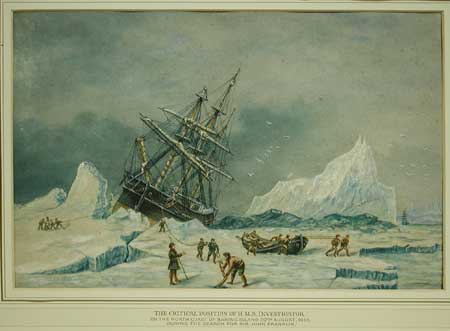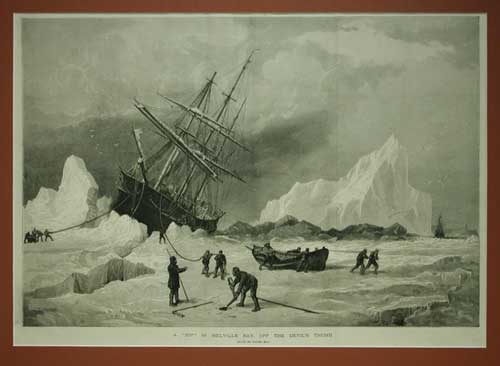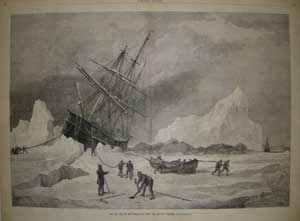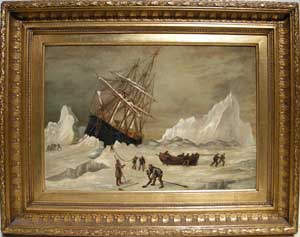
Despite the splendid, but alas erroneous, title the above watercolour is based on a compilation of sketches by W. May of HMS Assistance nipped in the ice on his two voyages.
On his second Arctic voyage 1852-54 May joined Sir Edward Belcher’s searching squadron HMS. Assistance, Pioneer, Resolute, Intrepid, North Star [Phoenix & Talbot supply ships] which left London 15 April 1852 -28 Sept.1854, as Lieutenant on HMS. Assistance (Capt.Sir Edward Belcher).
The Assistance sailed up Wellington Channel to make new discoveries in the Grinnell Pen, Devon Is. Sledging parties made discoveries in Bathurst Is. and Sabine Peninsula, Melville Is.
From Northumberland Sound, where they over wintered, again many searching parties were undertaken to determine the fate of Franklin. May commanded the Sledge Reliance in 1853 as far as Melville Is. in support of Osborn’s sledge search party.
Meanwhile HMS. Investigator (Capt.R.J.Le M.McClure) also on a Franklin searching expedition, entering from the Beaufort sea, via Bering streight. Whilst proceeding up Prince of Wales strait had become trapped in the ice about 40 km. from Melville Sound, they were able to extricate themselves, turn about and sail clockwise around Bering Is. (now Banks Is.) over wintering in Mercy Bay on the north of the Island, there the ship became fatally beset once more.
Sledging parties from HMS. Resolute had picked up a note of Investigator’s plight, which had not been heard of since 1850. Upon re-establishing contact, the decision was made to abandon the ship on 3 June 1853, the crew being transferred to the Resolute; she too became beset by ice in August of that year. In 1854 Belcher ordered the abandonment of HMS Intrepid. and the Resolute (which later drifted out to sea, where she was discovered by American whalers and eventually returned to England.) The crews of all three unfortunate ships joining those of the Assistance and Pioneer which also had to be abandoned, and being distributed among the surviving three ships for the journey home. They arrived in Sept 1854, whereupon May’s promotion to the rank of Commander was confirmed. May Inlet on Bathurst Is. is today named in his honour.
Walter May complied the prophetic, image of this typical scene based upon his own experiences, observations and drawings and probably the inspiration for T.S. Robbins painting of HMS. Assistance. May then sold his sketch to the Illustrated London News appearing as a wood engraved supplement on 22 May 1875 with the title A 'Nip' in Melville Bay, off the Devil’s Thumb. Its publication timed to coincide with the eve of departure of G. S. Nares Polar expedition in HMS Alert on 29 May 1875.
Contd. below....






